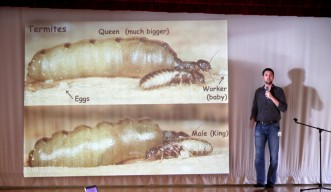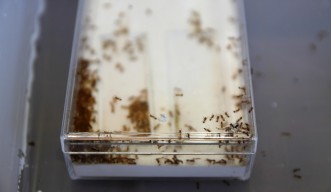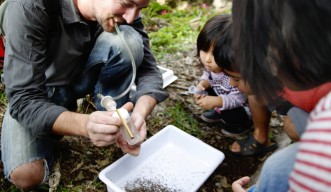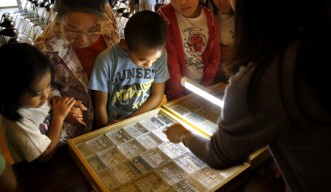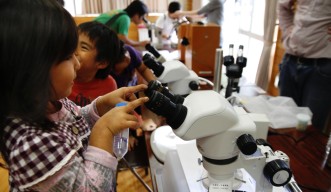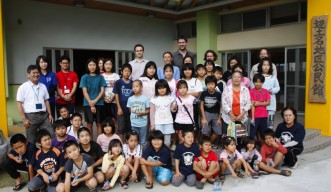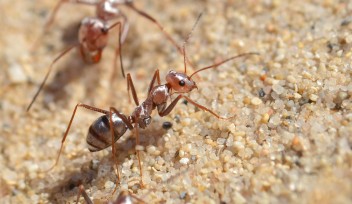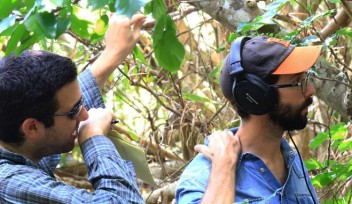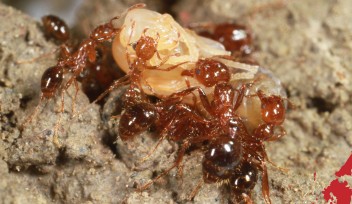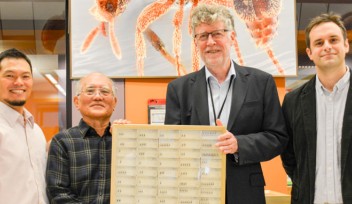Thinking Globally, Acting Locally
While conducting research for the global stage is one of OIST’s main objectives, giving back to the local Okinawan community is equally important to the university and its researchers. In an effort to expose children living on the island to the wonders of science, on December 16th, 2012, members of Biodiversity and Biocomplexity Unit at OIST made a trip to the small northern Okinawan town of Kunigami to take about 30 local children on an ant and termite adventure.
“Scientists want to observe the world around them and study things that are sometimes right under their noses,” Professor Evan Economo, head of the Unit, told the children. “We are very lucky to live in Okinawa and we hope that when you grow up you’ll come and do research with us.”
After a short presentation on the diversity and life of social insects by Benoit Guénard, a postdoctoral researcher in the Unit, the mostly elementary school-aged children broke into four groups to learn more about these tiny creatures. At one station, Beatrice Lecroq, also a postdoctoral researcher in the Unit, showed the children how ants communicate with each other through the use of pheromones, a chemical substance produced and released by ants to transmit information like the location of food or the presence of a predator. At another table, Professor Economo and Sandrine Burriel, a visiting student in the Unit, helped children look at living and preserved ants under microscopes. The Unit also gave each child a tube to store insects in, which they caught outside with Guénard and Adam Lazarus, a research technician in the Unit. At one last station, the children drew on paper with ballpoint pens and watched termites follow the lines of their scribbles. Interestingly, the chemical composition of the ink in ballpoint pens is very similar to that of termite pheromones, explained Juanita Choo, a research scientist in the Science and Technology Group at OIST and Misato Okamoto, a postdoctoral researcher in the Evolution and Ecology Unit, who led this termite exhibit.
Many parents and grandparents who accompanied their children for the day seemed to be equally fascinated by the insects. After spending the day looking through microscopes and catching ants with her grandchildren, Hiroko Chibana, an 80-year-old grandmother, said: “We usually kill ants and other insects because they are seen as pests, but after today I will do my best not to kill them anymore. Today is a day of reflection.” Touched by her statement, Economo invited Ms. Chibana and her 9-year-old grandchild, Arata Chibana, to his laboratory for a tour. According to his grandmother, Arata is already taking an interest in biology and insects in particular. “His room is full of scientific gear,” she said.
This event is one of three visits OIST and the Okinawan Prefectural Government are working together to organize. In January Sakurako Watanabe, a graduate student at OIST and Kohgaku Eguchi, a researcher in the Cellular and Molecular Synaptic Function Unit, will travel to Miyakojima, an island between the main Okinawa island and Taiwan, to talk with children about their research and science in general. Also in January, Larisa Kiseleva, a researcher in the Biological Systems Unit, will be going to Iriomote Island, which is located near Miyakojima, to give a talk and perform several experiments with children, including banana DNA extractions. In the coming months OIST researchers will also be giving talks for children at junior high schools around Onna as a part of another initiative between the university and the Onna-son Board of Education.
For press enquiries:
Press Inquiry Form
